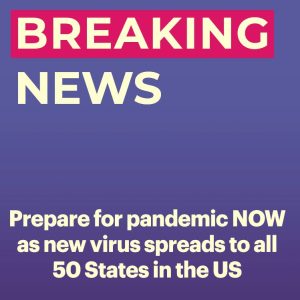Bird flu is becoming a bigger threat to the US as experts warn of the possibility of a pandemic.
April 2025: As the H5N1 avian flu virus continues to worsen in the United States, top international health experts are raising the alarm. The Global Virus Network (GVN) and other top virologists are warning that the US could be on the verge of another pandemic as outbreaks on American farms are getting out of hand.

A unusual and alarming occurrence is that the avian influenza outbreak, which started to worsen in 2022, has now spread from poultry to dairy cattle. Almost 1,000 herds of dairy cows nationwide have tested positive for the virus. The virus’s influence on public health has significantly and concerningly increased, with over 70 human infections documented so far, including at least one recorded death.
There is tremendous strain on the chicken business in the United States, which has long been at the forefront of zoonotic disease risks. More than 168 million birds have died from infection or culling since the outbreak began. In addition to pushing egg prices to all-time highs and jeopardizing the security of food supply systems, the economic cost is huge.
The GVN’s experts are particularly worried about high-density farming areas, where animals are housed in close quarters, and agricultural workers’ uneven use of personal protective equipment (PPE). These circumstances raise the possibility of cross-species transmission and provide the perfect setting for viral proliferation.
Despite the fact that no persistent human-to-human transmission of H5N1 has been documented thus far, virologists caution that the virus’s potential for mutation presents a significant risk. The potential for reassortment, in which two distinct viruses co-infect the same host and exchange genetic material, is one of the biggest worries. A disease that might cause a worldwide health emergency could arise if H5N1 were to reassort with a virus that is easily spread among people.
“The risk is not hypothetical,” stated Dr. Peter Palese, director of the Global Virus Network and a pioneer in influenza research. “We are witnessing a virus that is spreading to new hosts, changing quickly, and overcoming species boundaries. If the proper changes take place, that particular virus has the potential to trigger a pandemic.
The GVN is urging immediate international cooperation in response to the worsening situation. Developing and stockpiling vaccines and antiviral medications specific to H5N1 and related influenza strains; educating the public and farm workers about the risks of H5N1, safe handling of poultry and dairy products, and early symptoms of infection; enforcing strict biosecurity measures across farms and animal processing facilities, including improved hygiene protocols, the use of personal protective equipment (PPE), and improved animal housing conditions; and bolstering surveillance systems to quickly detect new outbreaks and track genetic changes in the virus are some of the main recommendations.
Dr. Palese stated, “Governments cannot afford to repeat the mistakes of the COVID-19 pandemic.” “We must take proactive rather than reactive action. Later, preparation will save lives.
It’s become more difficult to overlook the similarities to the early stages of COVID-19. Now, a virus that was mostly disregarded outside of specialist scientific circles is spreading throughout the general public. The perfect storm is being created by the combination of weak farm-level precautions, low public awareness, and animal-to-human transfer.
The public is being advised by health officials to use caution rather than panic. The World Health Organization (WHO) and the U.S. Centers for Disease Control and Prevention (CDC) are keeping a careful eye on the outbreak and its effects on public health around the world.
The developing H5N1 problem is a test of political will, international collaboration, and public health infrastructure in addition to research. Health experts maintain that we cannot afford to be complacent, especially because the COVID-19 pandemic is still fresh in our minds.
“A pandemic can still be avoided,” Dr. Palese stated. That window, however, is closing. We need to act swiftly this time, before it’s too late, using the skills, resources, and frameworks we’ve built since 2020.
